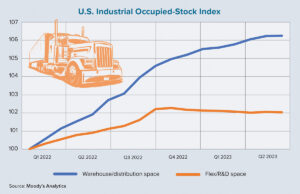With an ever-changing array of lenders and evolving payment systems such as PayPal, Venmo and Google Pay, the financial industry can seem chaotic and confusing even in the best of times. In today’s real estate market, however, commercial mortgage brokers must contend with another source of uncertainty — the potential end to one of longest economic expansion periods in U.S. history.
Although many experts believe the economy remains on solid footing with near-record unemployment, strong gross domestic product growth and stable inflation, economic expansions don’t last forever. Many leading forecasters have predicted that a recession will arrive sometime in 2020.
The news about the economy is contradictory, conflicting and inconsistent. So, who is right? Although we don’t know precisely when the next downturn will happen, it is clear that commercial mortgage brokers and lenders need to prepare for the possibility.
Prepare for a downturn
Your brokerage will have a better chance of surviving the next recession with minimal negative impacts by developing a specific plan of action. Start by asking these questions: Where do we go from here and what is the future of our company? Perhaps the better question is, where do you want to be in three to five years?
A good place to begin is by creating a list of economic- downturn possibilities, somewhat like a worst-case analysis. Identify how bad things could become. Once complete, develop appropriate defensive actions. You need to establish a precise and specific series of tasks, steps and resources required to establish clear-cut corrective actions. Your business strategy should be to build a high-performance brokerage based on operating practices that continuously result in sustainable earnings and staying power that will withstand future economic downturns.
Your goals also should be measurable and quantifiable. Define your business’s desired annual new-loan volume target, its annual percentage growth rate, and the specific industries and geographic regions that comprise your desired market. Once these questions are answered, it becomes easier to more clearly define future strategies for when a downturn hits.
As illogical at this sounds, it may be possible to increase your loan volume during more difficult times by cutting transaction-related costs, reducing margins and modifying certain loan terms, as well as by seeking new loans in specific industries or by curtailing lending in others. You also will likely have to make a difficult decision about whether to lay off employees to control costs.
Take specific steps
Mortgage brokers can take several steps to prepare for the coming downturn. Step one involves improving your brand. Building a strong, recognizable brand will pay endless benefits that include enhanced name recognition, word-of-mouth referrals, customer loyalty and greater credibility.
A brand is one of the company’s most valuable assets. Create professional-looking letterhead, envelopes, business cards, flyers and a website. This is all part of building a brand, but it takes time and can be costly.
Brokers also need to be strategic in how they present loan proposals to lenders. You should put together a loan package in the lender’s desired format. This isn’t doing the lender’s work, but it makes it easier for the lender to say “yes.” This will show the lender your level of commitment to expedite their underwriting process and will accelerate your own payday.
You should practice and sharpen your basic underwriting skills. Underwriting is a perishable skill that can grow stale if not continuously used. Lenders want to work with a broker who can accurately analyze and prequalify the potential borrower.
Given that accounting is the language of business, the broker should collect the borrower’s financial data and identify the financial strengths and weaknesses of the potential deal. Try to verify the borrower’s numbers, balance sheet and income statements. Also be sure to point out any deficient areas and explain these issues to the lender. By bringing issues with the deal to the surface, a broker will demonstrate a thorough understanding of the borrower’s financial position.
You need to find ways to work smarter and close deals faster. Time is a broker’s most precious asset. The sooner a lender agrees to fund a loan, the sooner a broker can move on to the next deal. Either way, we all should embrace the concept of today over tomorrow. One way to increase your speed is by automating work processes to the extent that the benefits of automation justify the costs. Automation has the potential to create faster and more professional presentations, all of which will be appreciated by borrowers and lenders, and should mean that the broker will receive their commission sooner.
Sharpen your focus
You should clearly define the loan-size range that fits with your experience, skills and knowledge level. Large loans are a tempting niche, but unless one has the experience and special relationships with these types of borrowers and lenders, larger loans tend to consume a lot of time and frequently do not work out.
In the same vein, be cautious about getting involved in international loans without having the background, experience and banking contacts. They are generally complex, time-consuming and involve a higher level of risk. Loans involving international clients frequently don’t close.
High-producing mortgage brokers are always aware of their company’s performance. You should monitor performance and trends, new loan volume, and prospective deals in the pipeline. If new business is trending down, determine the reasons why. Always try to have 12 to 15 loans in process. If your backlog is too large, however, it may become difficult to serve clients in a timely manner. There always will be times when you can’t help a potential client. When that happens, accept it and move on, but always depart on a professional basis. Frequently, there is a next time.
You also may have to change long- standing business practices in order to strengthen your position and staying power. Change is often difficult for many people. It requires commitment, open communication, and accepting the views and ideas of others. You may need to alter individual paradigms and long-standing philosophies of how business is done. Change usually starts at the top, cascading down and throughout the organization.
• • •
To survive the next downturn, you might have to change what employees do, as well as how and why they do it. You will almost certainly need to inquire about the internal changes that are needed to openly embrace innovation and transformation in your company. These changes should take you in one direction — forward.
Author
-
Garry Barnes is managing director of PW Partners Consultancy, headquartered in Salt Lake City, and is a freelance writer. He is a former president and CEO of banks in Arizona, California and Utah. He has taught at the university level, and is a frequent writer and lecturer on banking, finance and real estate matters. Barnes has served on the U.S. Small Business Administration’s National Advisory Council and received the SBA Arizona Financial Services Advocate of the Year award.





